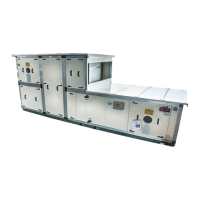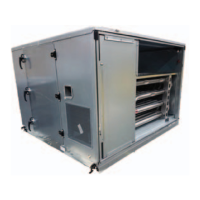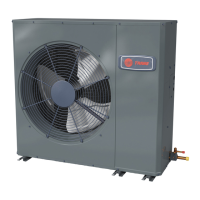Maintenance
37
4. Air Filters
5. Drain Pans
Steam, hot water and chilled water coils should be kept clean
to maintain maximum performance. lf fins become dirty, clean
with steam and detergent, hot water spray and detergent, or
one of the commercially available chemical coil cleaners.
Rinse coils thoroughly after cleaning.
In the event of coils being out of commission for some time, it
is advisable to completely drain down the coil. On each
occasion when refilling is undertaken, check that the coil is
effectively vented.
Periodic cleaning of the coils is required.
Dirty coils have increased airside pressure drops and reduced
heat transfer, thus unbalancing the cooling or heating system.
In the event that fin edges have been bent, they can be
straightened with the aid of a coil comb. The cleaning is
carried out with the unit intact using a powerful vacuum
cleaner on the dust-contaminated side. If the unit is very dirty
it will need to be removed and wet cleaned.
If required, soft cleaning brushes may be used ensuring that
the heat exchanger fin are not damaged. Frost protection.
Check that frost protection is working before the
commencement of each winter period. Ensure that the frost
sensor is correctly installed and fitted and is working within the
correct temperature range.
Check the cleanliness of the droplet separator section and the
blades annually. If the blades are dirty, remove and clean
them. Contamination can result in damage through water
droplets in the system’s performance. Ensure that the blades
are correctly repositioned and that they are not distorted.
WARNING
Follow all directions provided with chemical cleaners to
avoid personal injury and/or coil damage. Commercially
available chemical cleaners may contain caustic or
hazardous agents.
6. Coil Cleaning
Cleaning
Drop eliminator
Appendix B provides filter size, type and quantity. To replace
throwaway filters, install new filters with the directional arrows
pointing in direction of airflow. To clean permanent filters wash
under a stream of water to remove dirt and lint. Remove oil
filter (aluminium or grease filter) with a wash of mild alkali
solution. Rinse in clean, hot water and allow to dry. Coat both
sides of the filter by immersing or spraying it with Air Maze
Filter Lote W or equivalent. Allow to drain and dry for about 12
hours.
Inspecting Cleaning
The condensate drain pan and drain line must be checked to
assure that the condensate drains as designed. This
inspection should occur a minimum of every six month or
more often as dictated by operating experience.
For units with sloped drain pans: If evidence of standing water
or condensate overflow exists, steps should be taken to
identify and remedy the cause immediately. Refer to the
troubleshooting section of this manual for possible causes
and solutions. If microbial growth in the drain pan is observed,
it should be cleaned and removed immediately. Drain pans
should be cleaned using the following procedure:
1.
2.
3.
4.
5.
6.
7.
8.
9.
Disconnect all electrical power to the unit.
Don the appropriate personal protective equipment (PPE).
Remove all standing water.
Use a scrapper or other tools to remove any solid matter.
Remove solid matter with a vacuum device that utilizes
high efficiency particulate arrestance (HEPA) filters with a
minimum efficiency of 99.97% at 0.3 micron particle size.
Thoroughly clean the contaminated area(s) with a mild
bleach and water solution or an EPA-approved sanitizer
specifically designed for HVAC use. Carefully follow the
sanitizer manufacturer’s instructions regarding the use of
the product.
Immediately rinse the drain pan thoroughly with fresh
water to prevent potential corrosion from the cleaning
solution of the drain pan and drain line components.
Allow the unit to dry thoroughly before putting the system
back into service.
Determine and correct the cause of the microbial
contamination.
Be careful that the contaminated material does not contact
other areas of the unit or building. Properly dispose of all
contaminated materials and cleaning solution.

